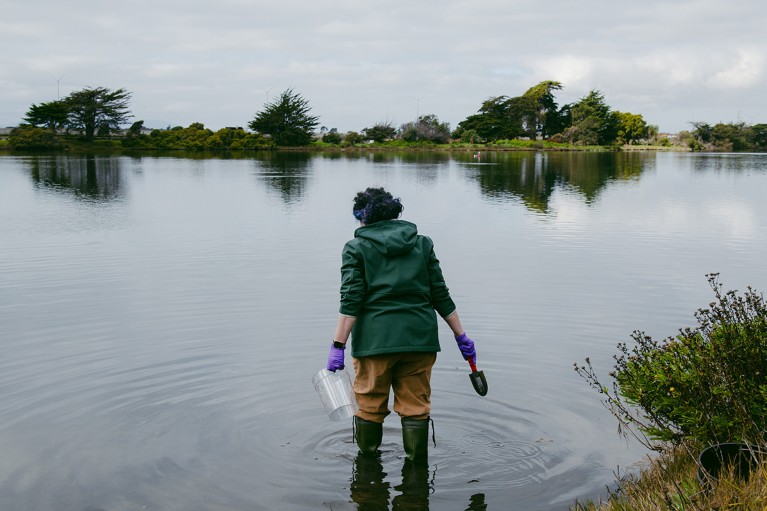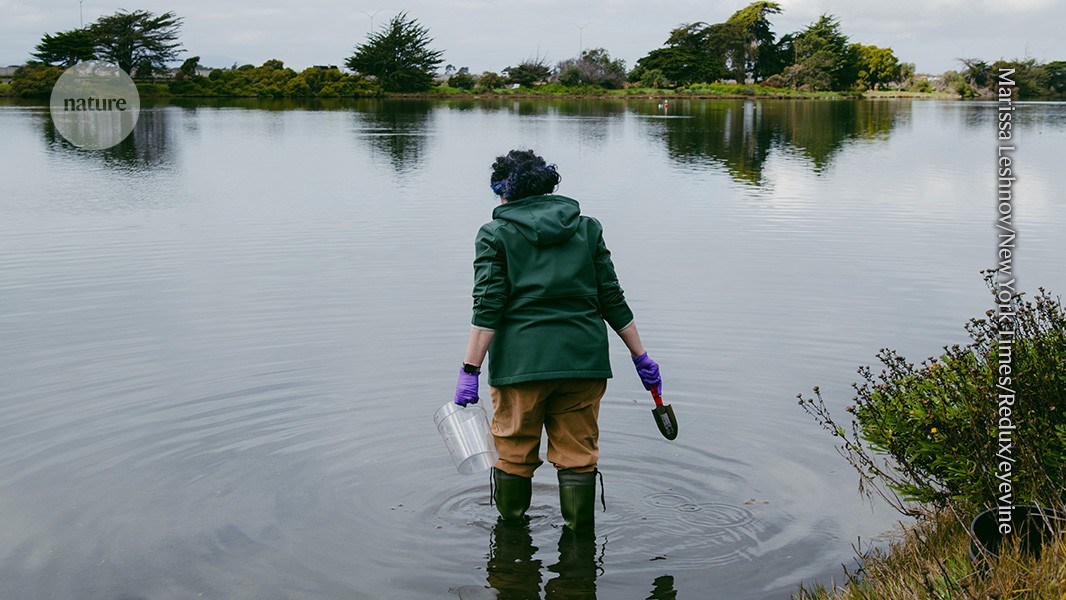
Felisa Wolfe-Simon, the lead author on the ‘arsenic life’ paper now retracted by Science, collects samples at Aquatic Park in Berkeley, California.Credit: Marissa Leshnov/New York Times/Redux/eyevine
A controversial paper1 claiming that an extraordinary microorganism can thrive on the toxic element arsenic has been retracted by the journal Science, nearly 15 years after its original publication. Some scientists are celebrating the move, but the paper’s authors disagree with it — saying that they stand by their data and that a retraction is not merited.
In Science’s retraction statement, editor-in-chief Holden Thorp says that the journal did not retract the paper when critics published take-downs of the work because, back then, it mostly reserved retractions for cases of misconduct, and “there was no deliberate fraud or misconduct on the part of the authors” of the arsenic-life paper. But since then, Science’s criteria for retracting papers have expanded, he writes, and “if the editors determine that a paper’s reported experiments do not support its key conclusions”, as is the case for this paper, a retraction is now appropriate.
Retraction notices are getting clearer — but progress is slow
“It’s good that it’s done,” says microbiologist Rosie Redfield, who was a prominent critic of the study after its publication in 2010 and who is now retired from the University of British Columbia in Vancouver, Canada. “Pretty much everybody knows that the work was mistaken, but it’s still important to prevent newcomers to the literature from being confused.”
By contrast, one of the paper’s authors, Ariel Anbar, a geochemist at Arizona State University in Tempe, says that there are no mistakes in the paper’s data. He says that the data could be interpreted in a number of ways, but “you don’t retract because of a dispute about data interpretation”. If that’s the standard you were to apply, he says, “you’d have to retract half the literature”.
Arsenic and old lakes
The original ‘arsenic life’ study was released by Science on 2 December 2010 — and quickly raised eyebrows.
Living things rely on a host of of common elements, including carbon, hydrogen, nitrogen, oxygen, phosphorus and sulfur, to build biomolecules such as DNA, proteins and lipids. For example, phosphorus — found mostly as the phosphate ion, PO43− — is essential to the structure of DNA and RNA and to the function of the energy-transporter molecule ATP.
The authors of the Science paper postulated that there might be organisms on Earth that don’t need all these elements. They sampled the arsenic-rich sediment of California’s Mono Lake and found a member of the Halomonadaceae family of bacteria that, they concluded after multiple types of analysis, could use that normally toxic element in place of phosphorus.

The microbe at the centre of the controversy over arsenic life was collected from sediment in California’s highly saline Mono Lake (pictured).Credit: Getty
After the paper was published, chemists and biologists took aim at it in journal submissions and on social media. Chemists said that if arsenic were incorporated into DNA’s backbone, the bonds would be so unstable that they would fall apart in water in less than a second2. Microbiologists, including Redfield, pointed out flaws in the work, such as that the bacterium’s growth medium contained enough phosphate contamination that, despite the team’s effort to prove that the organism could live on arsenic, it was probably still phosphate-dependent.
“There were very, very powerful reasons to think that the result must be wrong,” Redfield says.
In May 2011, Science published eight technical comments, one of them from Redfield, criticizing the paper3–10, alongside a response from the authors refuting the comments11. The next year, the journal published two studies12,13, including one from Redfield’s laboratory, attempting — and failing — to reproduce the results using bacterial samples from the arsenic-life team. But Science did not retract the paper. Until now.
Poisoned chalice?
In February this year, The New York Times published a story about Felisa Wolfe-Simon, the lead author of the study, which was released while she was a NASA astrobiology research fellow based at the US Geological Survey in Menlo Park, California. The story reported that Wolfe-Simon, after having her career derailed by the negative attention she received over the paper, has received short-term funding to pursue new research. It brought the controversy back into the light.
US project seeks standard way to communicate research retractions
Thorp told Nature: “We reached a point where the inquiries [about whether we’d retract the paper] continued, and we decided it was better to come up with a resolution that would, at least from our perspective, be the last word on this”.




